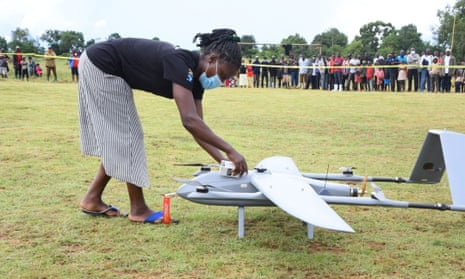As the bottles of medication are carefully loaded into the body of the drone, a small crowd gathers to watch on the other side of the yellow tape marking out the grassy landing strip.
With a gentle buzz the drone rises, a little uncertainly, into the sky, on its 1.5-metre wings. The precious cargo leaving Bufumira health centre III, in Uganda’s Kalangala district, is critical drugs for people living in some of the most far-flung communities in the region. Kalangala is made up of 84 islands in Lake Victoria, the world’s largest tropical lake, which Uganda shares with Tanzania and Kenya.
The drone taking off last week was a pilot for a new project which will now see 20 scheduled flights a month, carrying mostly HIV medicines out to 78 community groups and health facilities across the widely scattered Ssese islands, which have the highest HIV prevalence in Uganda.
Located about 60 miles from the capital, Kampala, and home to more than 67,000 people, Kalangala district has an HIV prevalence rate of 18%, far higher than the national rate of 5.6%. The government’s HIV strategy estimates prevalence of the virus to be up to 40% in some fishing communities.
The delivery of antiretroviral drugs (ARVs) and healthcare is difficult, weather-dependent and risky for healthcare workers, as travel into the region is possible only by boat. The drones, it’s hoped, which cost about £4,000 each, carry loads of up to 1kg and fly for 150km, will “close that last mile”, said Andrew Kambugu, executive director at Makerere University Infectious Disease Institute (IDI).
“Closing the last mile of delivery and ensuring that people living in remote communities have equitable access to modern treatments for HIV is one of the most significant challenges in global health and in Uganda,” he said.

“Medical drones can help solve this challenge by safely and reliably delivering lifesaving medications, thereby empowering frontline healthcare workers to allocate more time and resources to performing other essential services, resulting in healthier and more resilient communities.”
Uganda’s ministry of health, the Academy for Health Innovation, Uganda, and IDI collaborated on the medical drones pilot at Bufumira, which carried ARVs to more than 1,000 people living with HIV.
The “overcoming geographical barriers with technology” initiative will ease challenges, said Henry Mwebesa, Uganda’s director general of health services, who watched the launch.
“Using medical drones is a huge step for us as a health sector in improving service delivery especially in hard to reach areas,” he said.
“It’s very useful. Once it’s successful we can adopt it for other facilities and replicate it in other places.”
The drones are controlled by locally trained experts who monitor the flight and landing.
“This is exciting. It will ease the transportation of vaccines to our health facilities in those landing sites,” said Jude Matovu, in charge of the Bufumira health centre. “So we expect our outpatient department coverage to increase.”
The Uganda Medical Association has welcomed the drones, but expressed concern over drug shortages due to inadequate funding. Its secretary general Mukuzi Muhereza said: “We are welcoming it. It’s very important and it could be a gamechanger. It would be nice to see whether it really works with our bad network and connectivity.
“While the distribution and delivery is welcome, the other biggest problem I see is that even other public health facilities get stock-outs even when they can be reached by road. So the stock-outs I don’t think would be because of the transportation or connectivity. The biggest stock-outs are because of the funds,” he said.
“Realistically I think we are not giving enough money to national medical stores to purchase drugs and supplies for every Ugandan that needs it. The biggest change would be if we can enhance the budget and make sure we have what [we need] to send.”
Other African countries, including Rwanda and Ghana, are also using drones to deliver blood and medical supplies, with the technology estimated to be serving more than 22 million people.

Rosalind Parkes-Ratanshi, director at the Academy for Health Innovation, said the programme will also be an important research opportunity to assess and quantify how effective drones are at delivering medications, data that will help scale drone technology and respond to emergencies.
“Thanks to the support and coordination of our partners, including Johnson & Johnson, this programme will help gather the information and data needed to help make this future a reality, while also helping to deliver lifesaving care to people in need,” said Parkes-Ratanshi.
